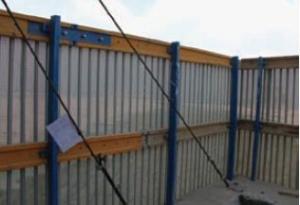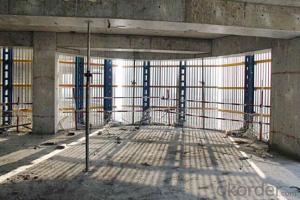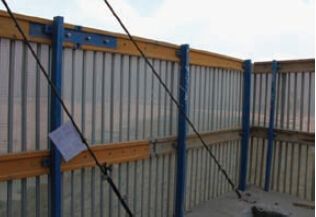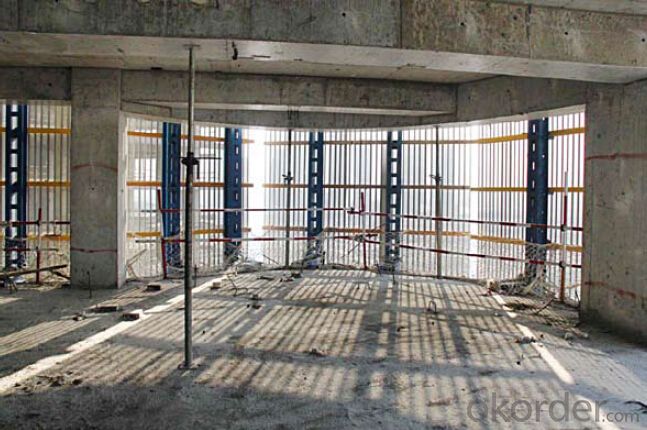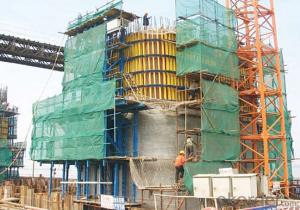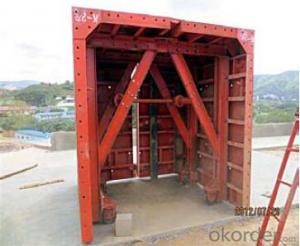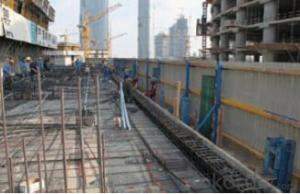Protection Platform for Formwork and scaffolding system
- Loading Port:
- Tianjin
- Payment Terms:
- TT OR LC
- Min Order Qty:
- 50 m²
- Supply Capability:
- 1000 m²/month
OKorder Service Pledge
OKorder Financial Service
You Might Also Like
Protection Platform PP-50
A kind of new type construction protection system, applying operating platform and safer job
location for construction corps.
Characteristics:
◆ Easy and quick assembling.
◆ Lifted as a group, it is rapid and economic.
◆ Auto-climbing
◆ A safe and reliable anchor system
1. Composition
2. Assembly process of anchor system
(1) Embed V-climbing cone and anchor plate into the slab.
(2) Fix anchor shoe on the slab by tensile bolt.
(3) The fixed anchor shoe.
◆ High work efficiency with work platform and unload platform
◆ High light transmittance with the hollow block


- Q: What are the common challenges associated with steel formwork?
- Construction projects face several common challenges when it comes to steel formwork. One of the main obstacles is the high initial cost associated with purchasing or renting steel formwork compared to other materials like wood or plastic. Although steel formwork is more durable and has a longer lifespan, smaller construction companies or projects with limited budgets may find the upfront investment prohibitive. Another issue is the weight and handling of steel formwork. Due to its heaviness, transporting, assembling, and dismantling steel formwork on-site can be challenging. This may necessitate additional labor and equipment, leading to increased construction costs. Proper installation and alignment of steel formwork also require skilled labor. Achieving the desired dimensions and finishes of concrete structures relies heavily on the accuracy and precision of the formwork. Mistakes or misalignments during setup can result in costly rework or compromised structural integrity. Maintenance and storage of steel formwork pose their own challenges. Regular cleaning and treatment are necessary to prevent rust and corrosion, particularly in humid or coastal areas. Sufficient storage space is also essential for protecting the formwork from external elements when not in use. Lastly, customization and adaptability can prove challenging with steel formwork. Unlike wood formwork, which can be cut and shaped on-site, steel formwork requires prefabrication and customization before use. Any changes in design or dimensions during the construction process may require additional time and cost to modify or replace the steel formwork components. Despite these challenges, steel formwork offers numerous advantages, including durability, reusability, and high-quality finishes. By implementing proper planning, training, and maintenance, these challenges can be effectively managed to ensure the success of construction projects.
- Q: What are the common quality control measures for steel formwork systems?
- Steel formwork systems commonly undergo several quality control measures to ensure their effectiveness and safety in construction projects. These measures include: 1. Visual assessment: A thorough examination of the steel formwork system's condition is conducted to identify any noticeable defects, such as dents, cracks, or deformations. Damaged or compromised components must be promptly repaired or replaced. 2. Measurement and dimensional verification: Ensuring accurate measurements and dimensional alignment of steel formwork components is crucial. This is achieved by utilizing precise measuring tools and equipment to guarantee a proper fit. 3. Inspection of welded joints: Since welded joints are often used to connect various components of steel formwork systems, it is vital to conduct comprehensive inspections to detect any defects, like cracks or incomplete penetration. Non-destructive testing methods, such as visual inspection, ultrasonic testing, or magnetic particle testing, may be employed to evaluate the weld quality. 4. Load testing: To validate the structural integrity and load-bearing capacity, load testing is performed. This procedure involves applying a predetermined load to the system and evaluating its performance under stress. It helps identify any weaknesses or defects that could compromise the formwork's safety and stability. 5. Examination of surface finish: The surface finish of steel formwork systems must be smooth and devoid of roughness or irregularities that could affect the quality of the concrete finish. Inspections are carried out to ensure that the formwork surfaces are adequately cleaned, treated, and coated, if necessary. 6. Documentation and traceability: It is imperative to maintain proper documentation and traceability of the steel formwork system components. This includes keeping records of inspections, repairs, replacements, and other pertinent information. Proper documentation ensures timely and accurate resolution of any issues or concerns that may arise. These quality control measures are indispensable for guaranteeing the durability, safety, and performance of steel formwork systems in construction projects.
- Q: What are the different types of supports used in steel formwork systems?
- There are several types of supports used in steel formwork systems, including adjustable steel props, scaffolding, bracing systems, and shoring systems. These supports are designed to provide stability and structural integrity to the formwork system during the concrete pouring process.
- Q: Can steel formwork be used for commercial construction projects?
- Yes, steel formwork can be used for commercial construction projects. Steel formwork offers durability, strength, and the ability to withstand heavy loads, making it a suitable choice for large-scale construction projects such as commercial buildings. It provides a stable and reusable solution that allows for efficient and precise concrete placement, ensuring high-quality results.
- Q: What are the different types of connectors used with steel formwork?
- There are several types of connectors commonly used with steel formwork, including wedge bolts, pin and wedge systems, clamps, and snap ties. These connectors are used to securely join the steel formwork panels together, ensuring stability and alignment during concrete pouring and curing processes.
- Q: Can steel formwork be used for both residential and industrial construction projects?
- Yes, steel formwork can be used for both residential and industrial construction projects. Steel formwork is highly versatile and can withstand heavy loads, making it suitable for various construction applications. Its durability and strength make it ideal for use in both residential and industrial settings.
- Q: What are the common finishes available for steel formwork?
- Some common finishes available for steel formwork include galvanized, painted, powder coated, and epoxy coated finishes.
- Q: Are there any specific considerations for using steel formwork in seismic zones?
- Using steel formwork in seismic zones comes with several specific considerations. Firstly, steel formwork offers superior strength and stiffness compared to other materials like wood or aluminum. This is crucial in seismic zones where the structure must withstand the lateral forces caused by earthquakes. The high strength of steel formwork helps prevent deformation or failure during seismic events. Secondly, steel formwork is known for its durability and reusability, which is especially important in seismic zones with frequent earthquakes. The formwork needs to withstand multiple cycles of loading and unloading, and steel formwork's robustness and ability to handle repeated use make it suitable for seismic zones where replacing formwork regularly may not be feasible. Another consideration is the design of the steel formwork panels. In seismic zones, it's important to ensure the panels have sufficient stiffness to resist lateral forces. This can be achieved by using thicker steel plates or adding stiffening elements to the formwork structure. Additionally, the joints between formwork panels should be well-designed and properly reinforced to resist the dynamic forces brought on by earthquakes. Furthermore, the connection between the steel formwork and the supporting structure must be carefully designed. In seismic zones, a strong and rigid connection is crucial to prevent the formwork from detaching or collapsing during an earthquake. Adequate reinforcement, proper anchorage, and well-designed joint details are essential for the stability of the formwork system under seismic loads. Lastly, the construction sequence and timing of formwork removal should be considered in seismic zones. The formwork should provide sufficient lateral support to the concrete during the curing process, as premature removal can compromise the structural integrity. Careful planning of formwork removal is necessary to avoid sudden changes in load distribution that could impact the seismic performance of the structure. In conclusion, using steel formwork in seismic zones requires considerations such as strength, durability, design, connection, and construction sequence to ensure the safety and stability of the formwork system and the overall structure during seismic events.
- Q: What are the different types of steel connectors used in steel formwork?
- There are several types of steel connectors used in steel formwork, including wedge bolts, tie rods, formwork clamps, anchor nuts, and wing nuts. These connectors play a vital role in securing and stabilizing the formwork system, ensuring the structural integrity and safety of the concrete construction process.
- Q: How does steel formwork handle concrete pouring in cold weather?
- Steel formwork is a preferred choice for concrete pouring in cold weather due to its durability and ability to withstand extreme temperatures. It acts as a protective barrier against freezing temperatures, preventing the concrete from freezing too quickly, which could lead to weakened structures. The steel formwork also helps to retain heat generated during the concrete curing process, ensuring proper and consistent curing even in colder conditions.
Send your message to us
Protection Platform for Formwork and scaffolding system
- Loading Port:
- Tianjin
- Payment Terms:
- TT OR LC
- Min Order Qty:
- 50 m²
- Supply Capability:
- 1000 m²/month
OKorder Service Pledge
OKorder Financial Service
Similar products
Hot products
Hot Searches
Related keywords
